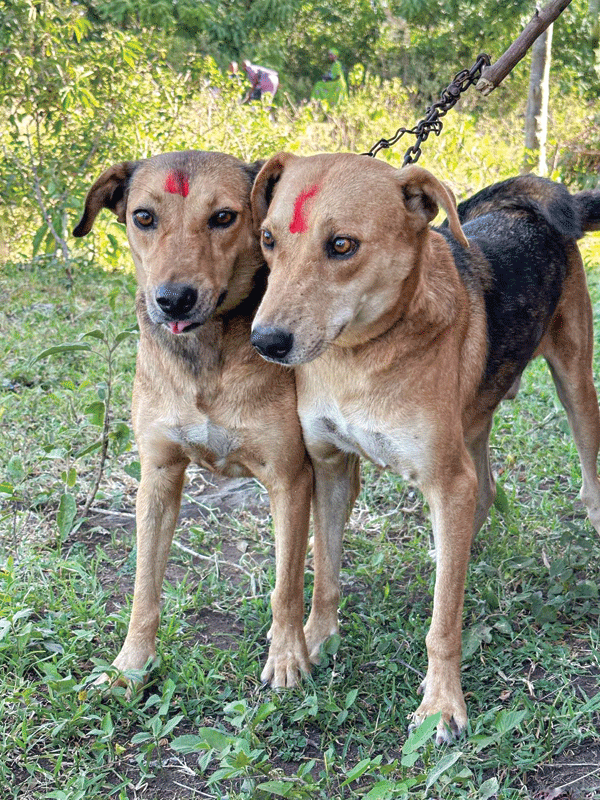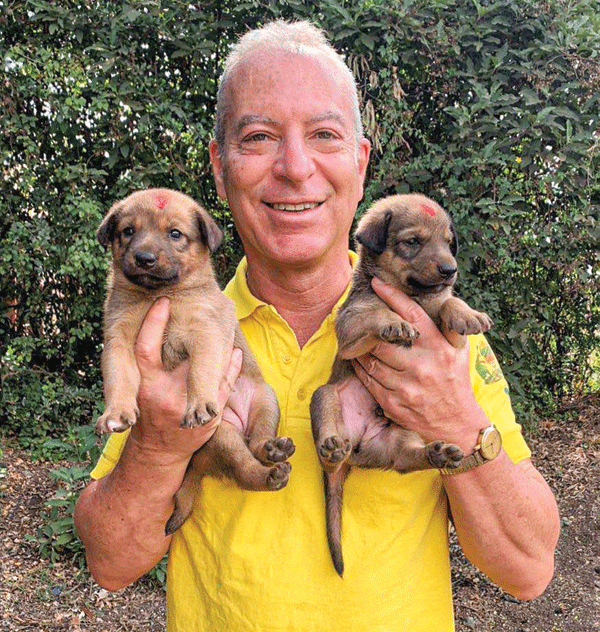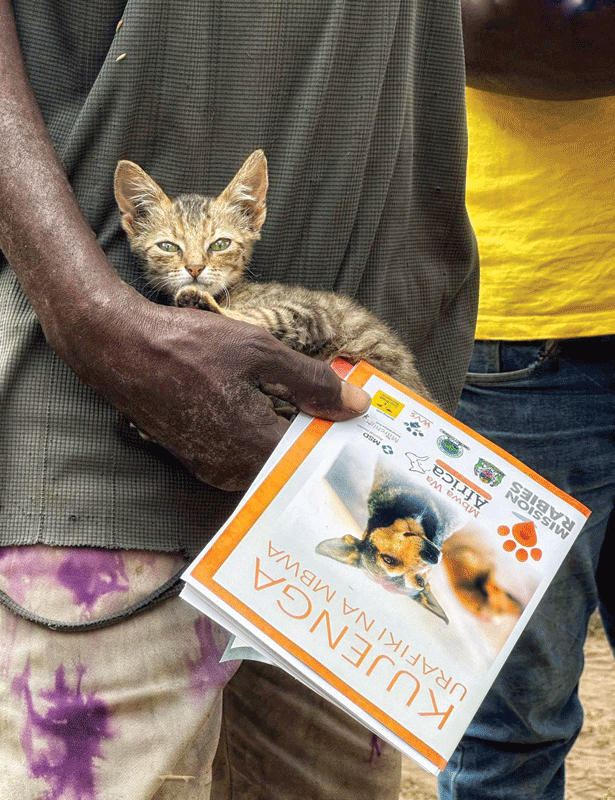
Photos courtesy Arnold Plotnick
Arnold Plotnick, DVM, was flipping through a veterinary trade magazine, when his attention was caught by an ad for an organization called Mission Rabies, seeking participants to help vaccinate dogs and cats in countries where rabies is endemic. Dr. Plotnick, a retired veterinarian who lives in New York City, is an avid traveler, as well as being concerned about rabies prevention, and the ad struck a chord with him. He investigated further, applied to go on the trip, and soon found himself on a plane to Goa, India.
That was in October 2018. Since then, Plotnick has also joined Mission Rabies teams to vaccinate pet dogs and cats against rabies in Ghana and Tanzania, participating in four trips so far.
“In the U.S., maybe one person a year dies of rabies,” he says, “and when it happens it’s almost always from the bite of a bat. But in the rest of the world, especially in Asia and Africa, 59,000 people die every year from rabies, and it’s mostly from the bite of a dog.”
A public health concern
Rabies occurs in more than 150 countries and territories, and 40 percent of the victims are children under 15 years of age, according to the World Health Organization (WHO). People who come into contact with rabid mammals can be exposed to the vaccine-preventable viral disease through a bite, or when mucous membranes or open wounds become contaminated with infected saliva or nervous tissue.
Mission Rabies launched in India in 2013, after the country was identified as the worst affected by rabies. Indeed, 35 percent of all human rabies deaths are estimated to occur in the country. That year, they vaccinated more than 60,000 dogs across 14 cities over a period of four weeks.
In 2014, Plotnick says 17 people died of rabies in Goa, India. The next year, only five people there died, and the following year it was down to two. By the time the team Plotnick was on arrived in 2018, no human deaths had occurred from rabies, and that status has continued through 2022.

In June 2021, Goa became the first Indian state to be declared a “rabies-controlled area,” setting a precedent for other states to follow.
The WHO has a goal to eliminate human rabies deaths by 2030, known as the Global Strategic Plan Zero by 30. Rabies prevention plans typically take a two-pronged approach of vaccinating at least 70 percent of dogs in a community—99 percent of all rabies transmissions to humans are via a dog bite—and preventing dog bites through education, informing adults and children about the canine body language signaling that a bite may be imminent.
In Tanzania this past January, Mission Rabies expanded its efforts in Meru District to more far-flung communities after a young boy died in 2021 from a bite by a rabid dog. A couple of weeks before that, a goat had been bitten by a rabid dog. The human and animal deaths are costly to communities, not only in terms of loss of life, but also loss of income, so vaccination programs contribute to a community’s emotional and financial well-being.
Economic and emotional costs
Globally, rabies-associated costs run $8.6 billion annually, according to the WHO. A One Health approach seeks to not only eliminate rabies in dogs—the most cost-effective strategy—but also to immunize people either after exposure—post-exposure prophylaxis, or PEP—or pre-exposure (PrEP) for people in high-risk occupations or who live or travel in remote areas where rabies is highly endemic and access to rabies biologics is limited or non-existent. It requires the engagement of multiple sectors and local communities to build awareness and conduct mass dog vaccination campaigns.
Organizations such as the Global Alliance for Rabies Control support community anti-rabies efforts with standardized tools, expert advice and other resources, and help to align and synchronize efforts in the same geographic regions so they are not duplicated.
Animal health is public health. Vaccinating animals against rabies anywhere in the world helps reduce the risk and incidence of the disease in humans and animals. It also helps to reduce instances of rabies being brought to North America when individuals or rescue organizations bring animals from Asia and Africa to shelters in the United States and Canada. Due to concerns about increased incidents of rabid dogs being imported, both countries have implemented regulations to prohibit entry of dogs from countries considered at high risk for rabies.
Helping wildlife
Rabies vaccination programs go hand in hand with protecting the denizens of natural environments. Land development and climate change affect habitat, often in ways that bring humans and domestic animals in closer contact with wildlife. That can result in greater transmission and spread of rabies, not only between domestic animals, but also from them to wildlife.
Vaccination of domestic dogs helps protect wildlife, such as the endangered Ethiopian wolf (Canis simensis). Many of the rare wolves, numbering fewer than 500, fall victim to rabies, often spread to them by contact with domestic dogs. Rabies and other infectious diseases are also a leading cause of mortality in African wild dogs, another rare species whose numbers are declining.
Anti-rabies programs include attempts to vaccinate Ethiopian wolves using oral rabies vaccines placed in mouse-size pieces of bait as well as efforts by the Cheetah Conservation Fund to vaccinate domestic dogs and cats in Namibia against rabies. Throughout Africa, such campaigns protect cheetahs, leopards, kudu, steenbok, and other wildlife. The result is good for wildlife, good for humans, and good for domestic animals.
Vaccination and sterilization are key
In addition to protecting animals from diseases, vaccination programs can open up opportunities to arrange for domestic dogs and cats to be spayed or neutered. Most recently in Tanzania, Mission Rabies partnered with a local animal welfare organization, Mbwa Wa Africa, which translates to “dogs of Africa,” just outside the city of Arusha. Together, the organizations vaccinated dogs across the at-risk communities of Meru District.
Alongside the vaccination work, Mission Rabies’ sister charity, Worldwide Veterinary Service, partnered with Mbwa Wa Africa to run a two-week sterilization campaign. Through combining sterilization and vaccination, the charities can more effectively help to control rabies and improve animal welfare in the area.

When Mission Rabies volunteers are vaccinating animals, they ask if the animal is sterilized and if not, whether owners would like to have them sterilized. If the answer is yes, they coordinate contact information between Mbwa Wa Africa and interested owners.
“They will often go out and pick up the dog and spay or neuter it and bring it back to the people because sometimes they’re far away from the clinic and may not have transportation,” Plotnick says. “When we were there, just over the seven days that we were vaccinating, we sent 250 animals to that clinic to be sterilized.”
While the program focuses on dogs, cats benefit, too. During the 2023 Tanzania vaccination effort, approximately 6,933 dogs were vaccinated, as well as 361 cats. Free-roaming cats are even less used to being restrained for vaccinations than free-roaming dogs, and they protest vocally and physically, but given the opportunity, people want to make sure they are protected.
“I have some pictures of people carrying cats in awkward ways, but they love their cats as well, and we go ahead and vaccinate them against rabies,” Plotnick says. “Transmission of rabies from cats to people is really tiny there, but they love their pets, and they want to get them vaccinated.”
Besides the satisfaction of protecting people and other animals from a deadly disease, one of the rewards of participating in this type of volunteer activity is seeing the human-animal bond in a different setting. While pets in other parts of the world might lead a more free-roaming lifestyle without the perks of more pampered North American and European dogs and cats, they are indeed companion animals. Plotnick has observed the bond as he interacts with people who bring their animals to be vaccinated.
“People who bring them to us are very fond of their animals; you can see it,” he says. “When we were in Goa, some of the animals were community animals. I went to one place and the guy had three dogs and he said, ‘These two are mine, and the other one just hangs around.’ But as far as I could see, they all looked like his dogs and he treated them all pretty much the same. They all had names and he vaccinated all of them. But in his mind, two of them were his and one was a community dog.”
The program is not limited to veterinarians, technicians, or veterinary students. Anyone who loves animals and is willing to spend grueling days beneath a blazing sun can volunteer to help.
Kim Campbell Thornton has been writing about dogs, cats, wildlife, and marine life since 1985, and is a recipient of multiple awards for her articles and books from the Cat Writers Association, Dog Writers Association of America, and American Society of Journalists and Authors.
